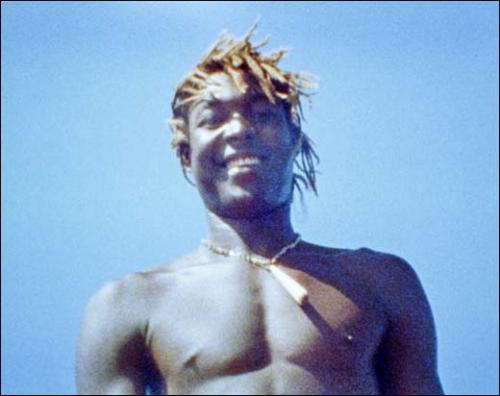 |
| Steve McQueen, Ashes (2014-15) |
I don’t know any other filmmaker who moves
so comfortably between mainstream and avant-garde film as does the British
artist/filmmaker Steve McQueen. And what makes him such a smart filmmaker is
that he is convincing in both forms. When watching 12 Years a Slave or Shame we don’t see a Hollywood film made by an
experimental filmmaker. Neither, at first glance, do we see any trace of
Hollywood in his latest installation at Marian Goodman’s Paris gallery.
Although there are familiar McQueen images, most obviously, the serenade
between the male body and McQueen’s camera, the image and story construction are distinct.
| Steve McQueen, Ashes, 2014-15 Making the Tomb |
Ashes is two faced: on one side of a screen, a handheld camera shows the
beautiful Ashes in a pair of shorts on the front of a boat. He plays around
with the camera, knowing how gorgeous he is, how perfect his body is. The
camera is lyrical, intimate, and filled with joy as the boat moves across the
Carribean Sea. The footage was apparently made during McQueen’s Caribs’ Leap in 2002, but he had never
used it. A voice over tells the story of a young man shot in the back on the beach
by drug dealers. I assumed it belonged to the projection on the other side of
the screen and had nothing to do with the gorgeous young man lolling around on
the front of the boat and sometimes falling in the water.
 |
| Steve McQueen, Ashes, 2014-15 |
Around the back, the image is a complete
opposite: two men, lovingly, make a tomb. They caress concrete to make the hard
edges perfect in tight, controlled frames. And then we realize, this is the
grave of the young man on the front of the boat, on the other side of the
screen. And the voiceover fills in the details of what we do not see. How Ashes
was killed. The love and care of the spread of concrete on the tomb becomes
devastating. It is as if they are enclosing the absence of the glistening young
boy’s body, dead, inside.
.jpg) |
| Steve McQueen, Remember Me, 2016 |
Like so much of McQueen’s installation
work, the real subject is absent, visually. The murder of Ashes, caught up in
the violent world of drugs that is the destiny for young Carribean men is not seen. The
story on the soundtrack also marks the absence of images, and the void is somewhere
in the incompatibility of the fluidity of a camera that celebrates life on the one
side, and the static, contained and tightly framed images of death on the other side of the screen. That the
story is absent makes it all the more powerful as we are left to imagine the
young boy on the beach, being chased by a gang, as it is told by Ashes’
friends. When we walk upstairs again to the gallery’s garden level, we cannot
help but be haunted by Ashes filled with life and joy on the boat. As we are
met by the wall of neon repetitions of “Remember Me”, each instance following a
unique handwriting, there’s no chance of forgetting what we did not see down
below.
Caught in between two sets of images that
might not have anything to do with each other if they were not on either side
of the same screen, it also occurred to me: isn’t that what narrative
filmmaking does? It’s just that the cut is transposed to a physical space that
requires we move around the screen to continue the narrative, rather than
sitting still in the cinema, anticipating the images that will come to us. Nevertheless, I was impressed by this film installation and inspired by its refusal to
represent it’s real subject: the violence and trauma of life of young men in
Grenada.
No comments:
Post a Comment